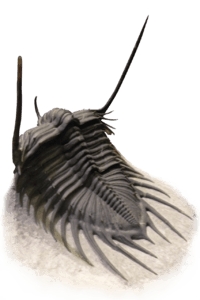Agnostida
| Agnostida Temporal range: Early Cambrian–Late Ordovician | |
|---|---|
| | |
| Itagnostus interstrictus | |
| Scientific classification | |
| Kingdom: | Animalia |
| Phylum: | Arthropoda |
| Class: | †Trilobita |
| Order: | †Agnostida Salter, 1864 |
| Families | |
|
Suborder Agnostina
Suborder Eodiscina
| |
| Synonyms | |
|
Isopygia Gürich, 1907 | |
Agnostida is an order of arthropod which first developed near the end of the Early Cambrian period and thrived during the Middle Cambrian. They are present in the Lower Cambrian fossil record along with trilobites from the Redlichiida, Corynexochida, and Ptychopariida orders. The last agnostids went extinct in the Late Ordovician.
Systematics
The Agnostida are divided into two suborders — Agnostina and Eodiscina — that are then subdivided into a number of families. As a group, agnostids are isopygous, meaning that their pygidium is similar in size and shape to their cephalon. Most agnostid species were eyeless.
The systematic position of the order Agnostida within the class Trilobita remains uncertain, and there has been continuing debate whether they are trilobites or a stem group. The challenge to the status has focused on the Agnostina partly because juveniles of one genus have been found with legs greatly different from those of adult trilobites,[1] suggesting they are not members of the lamellipedian clade, of which trilobites are a part. Instead, the limbs of agnostids closely resemble those of stem group crustaceans, although they lack the proximal endite, which defines that group. They are likely the sister taxon to the crustacean stem lineage, and, as such, part of the clade Crustaceomorpha.[2] Other researchers have suggested, based on a cladistic analyses of dorsal exoskeletal features, that Eodiscina and Agnostida are closely united, and that the Eodiscina descended from the trilobite order Ptychopariida.[3] Still others have argued that Agnostids are related to Brachiopods.
Ecology
Scientists have long debated whether the agnostids lived a pelagic or a benthic lifestyle. Their lack of eyes, a morphology not well-suited for swimming, and their fossils found in association with other benthic trilobites all suggest a benthic (bottom-dwelling) mode of life. They are likely to have lived on areas of the ocean floor that received little or no light and fed on detritus that descended from upper layers of the sea to the bottom. In contrast, their wide geographic dispersion in the fossil record is uncharacteristic of benthic animals, suggesting a pelagic existence. The thoracic segment appears to form a hinge between the head and pygidium allowing for a bivalved ostracodan-type lifestyle. Furthermore, the orientation of the thoracic appendages appears ill suited for benthic living. However, recent work suggests that some agnostids were benthic predators, engaging in cannibalism and possibly manifesting pack-hunting behavior.[4]
They are sometimes preserved within the voids of other organisms, for instance within empty hyolith conchs,[5] within sponges, worm tubes and under the carapaces of bivalved arthropods,[6] presumably in order to hide from predators or strong storm currents; or maybe whilst scavenging for food.[6] In the case of the tapering worm tubes Selkirkia, trilobites are always found with their heads directed towards the opening of the tube, suggesting that they reversed in; the absence of any moulted carapaces suggests that moulting was not their primary reason for seeking shelter.[6]
References
- ↑ Müller, K. J. & Walossek, D. (1987): "Morphology, ontogeny, and life habit of Agnostus pisiformis from the Upper Cambrian of Sweden". Fossils and Strata, 19, 1-124.
- ↑ Bergström, J. & Hou, X.G. (2005). "Early Palaeozoic non-lamellipedian arthropods". In S. Koenemann & A. J. Ronald (eds.), Crustacea and Arthropod Relationships (Volume , pp. 75-93). Taylor and Francis Group.
- ↑ Cotton, T. J. & Fortey, R.A. (2005). "Comparative morphology and relationships of the Agnostida". In S. Koenemann & R. A. Jenner (eds.), Crustacea and Arthropod Relationships (Volume , pp. 95-136). Taylor and Francis Group.
- ↑ McMenamin, M. A. S. (2010). "Cambrian cannibals: agnostid trilobite ethology and the earliest known case of arthropod cannibalism". Geological Society of America Abstracts with Programs, v. 42, no. 5, p. 320.
- ↑ Fatka, O.; Vokáč, V.; Moravec, J.; Šinágl, M.; Valent, M. (2009). "Agnostids entombed in hyolith conchs". Memoirs of the Association of Australasian Palaeontologists 37: 481–489. ISSN 0810-8889.
- ↑ 6.0 6.1 6.2 Chatterton, B. D. E.; Collins, D. H.; Ludvigsen, R. (2003). "Cryptic behaviour in trilobites: Cambrian and Silurian examples from Canada, and other related occurrences". In Lane, P. D; Siveter, D. J; Fortey, R. A. Trilobites and Their Relatives. Special Papers in Palaeontology 70. The Palaeontological Association. pp. 157–173. ISBN 9780901702814.
External links
- Order Agnostida by Sam Gon III.
- The Virtual Fossil Museum – Trilobite Order Agnostida
- Agnostida fact sheet by Sam Gon III.
- "Earth's Early Cannibals Caught in the Act", by Larry O'Hanlon, news.discovery.com.
| |||||||||||||||||||||||||||||||||||||||||||||||||||||||
